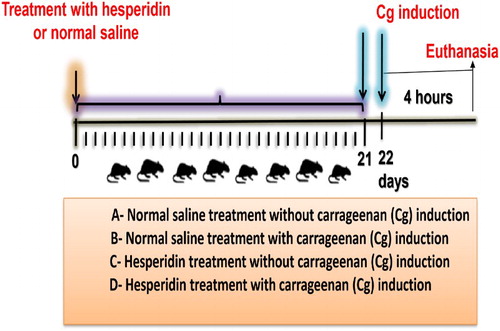ABSTRACT
Objectives: This study investigated the potential anti-inflammatory effect of hesperidin against carrageenan induced pleurisy in rat model.
Methods: Twenty-four adult female Wistar rats (350 - 450g) were grouped as follows: Group I: rats were administered saline solution only (Normal control group); Group II: rats were administered saline solution (NaCl 0.9%) orally and injected with carrageenan (Inflammation control group); Group III: rats were administered hesperidin only (Hesperidin group); Group IV: rats were administered hesperidin orally and intrapleurally injected with 2% carrageenan (Inflammation treated with hesperidin group). The exudate volume, total leukocyte count, reactive oxygen species (ROS), myeloperoxidase (MPO),δ–aminolevulinate dehydratase (δ-ALA-D), catalase (CAT), superoxide dismutase (SOD), activities as well as non-protein thiol group (NPSH) and thiobarbituric acid reactive substances (TBARS) levels were determined.
Results: Pretreatment with hesperidin at a dose of 80 mg/kg orally per day for 21 days, minimized the increase in pleural exudate volume and leucocyte count and modulated the activities of MPO, SOD and CAT, as well as the levels of ROS, NPSH and TBARS in carrageenan-induced rats.
Conclusion: Our results suggest that hesperidin can elicit its anti-inflammatory action by blocking exudate and leukocyte influx into pleural cavity, inhibiting MPO activity and preventing oxidative damage.
Highlights
Hesperidin blocks exudate and leukocyte influx into the pleural cavity.
Hesperidin inhibits myeloperoxidase activity in rat model of pleurisy.
The anti-inflammatory action of hesperidin in rat model of pleurisy is associated with its antioxidant mechanism.
1. Introduction
Pleurisy is an inflammation of the pleural cavity membranes surrounding the lungs [Citation1]. There are many possible causes of pleurisy but viral infections spreading from the lungs to the pleural cavity are the most common. The inflamed pleural layers rub against each other every time the lungs expand to breathe in air. This can cause sharp pain when breathing, also called pleuritic chest pain [Citation1]. There are several causes of pleurisy which include chest injury, viral infection and bacterial infection [Citation2]. Free radicals and oxidative stress have also been implicated in triggering and inducing pleurisy. Removal of the fluid, air or blood from the pleural space has been reported to be the commonest approach to the treatment of pleurisy along with paracetamol and anti-inflammatory agent, indomethacin [Citation2].
Carrageenan (Cg) is a high-molecular-weight, sulfated polysaccharide used for assessing the contribution of mediators involved in vascular changes that are associated with acute inflammation [Citation3]. Injection of Cg into the pleural space results in pleurisy, characterized by an immediate neutrophil movement out of the circulation into the inflamed tissue to function in the breakdown and remodeling of injured tissue [Citation4]. Another important occurrence is the migration and accumulation of exudates from the damaged tissues into the pleural cavity. This may subsequently cause significant alterations in inflammatory parameter [Citation5]. This local event induced by Cg is linked to the production of neutrophil-derived reactive oxygen species (ROS), such as hydrogen peroxide, superoxide, and hydroxyl radicals, and to the release of other neutrophil-derived mediators [Citation6].
ROS may induce lipid peroxidation and oxidative damage in cells which can potentially lead to inflammation as well as tissue injuries [Citation7]. Liver is the second largest organ in the body. It is responsible for the detoxification and blood cleansing, synthesis of vitamin, regulation of body fuel supply, control of cholesterol, hormonal balance and metabolism of drug [Citation8]. Carrageenan-induced acute inflammation may induce a number of injuries in tissues such as liver and lungs [Citation9,Citation10] by vast production of ROS [Citation11]. Thus, neutrophil recruitment and activation result in parenchymal lung damage as well as lung dysfunction by cell death-mediated oxidative damage to DNA, proteins and lipid peroxidation in the cell membranes [Citation12]. There has been an improvement in the use of dietary phenolic compound especially flavonoids due to their potential health effect, free radical scavenging ability as well as inhibition of lipid peroxidation in biological membranes [Citation13,Citation14].
Hesperidin is a flavonone that is primarily found in citrus fruit and has been reported to have beneficial effect on chemoprevention, alleviating pathological changes induced by aluminum, antioxidant, allergies, hemorrhoids, high blood pressure, hot flashes, hay fever, sinusitis, symptoms associated with menopausal changes, premenstrual syndrome and varicose veins [Citation15–18]. Hesperidin possesses higher reducing power, chelating activity on Fe2+, hydrogen radical scavenging and hydrogen peroxide scavenging activities when compared with some synthetic antioxidants such as α-tocopherol, ascorbic acid, butylated hydroxytoluene (BHT), butylated hydroxyanisole (BHA) and trolox [Citation19]. Clinical and experimental data showed the antihypertensive, lipid-lowering, insulin-sensitizing, antioxidative and anti-inflammatory properties of hesperidin [Citation20]. However, the protective role of hesperidin against carrageenan-induced pleurisy has not been investigated. We speculate that hesperidin may ameliorate liver damage and inflammation induced by carrageenan, with little or no side effects based on its possible pharmacological action. Hence, this study investigated whether administration of hesperidin offers protection against carrageenan-induced pleurisy using rat model.
2. Materials and methods
2.1. Chemicals and reagents
Hesperidin, 2′,7′-dichlorofluorescin diacetate (DCFH-DA), L o-dianisidinedihydrochloride, dihydrorhodamine 123, Tris–HCl, thiobarbituric acid, Coomassie Blue, delta aminolevulinic acid, trichloroacetic acid, 5-5 dithio-dis-(2-nitrobenzoic acid) (DTNB) (Sigma-Aldrich, U.S.A). All other chemicals and reagents used in this experiment were of the highest purity.
2.2. Animals
Twenty-four Adult female Wistar rats (5 months old, weighing 350–450 g) were used in this experiment. The animals were maintained at constant temperature (23 ± 1°C) on a 12 h light/dark cycle with free access to food and water. All animals were maintained in accordance with the guidelines on the use of animals, approved by the Ethics committee of the Federal University of Santa Maria (protocol number: 1071171215).
2.3. Experimental groups and carrageenan induction
The rats were pretreated with either sterile saline (NaCl 0.9%) or hesperidin (80 mg/kg) by oral gavage for 21 days. In this study, the hesperidin dose was chosen based on earlier report by Guardia et al. [Citation21]. On the 22nd day, all the animals were intraperitoneally injected with anesthesia (ketamine and chillaxin) about 30 min prior to the intrapleural (i. pl.) injection of carrageenan in inflammation group and saline solution in the control group (). The pleurisy was induced by injection of 0.2 mL of sterile saline solution (NaCl 0.9%) containing carrageenan (2%) (Sigma Chemical Co., St Louis, MO, U.S.A) into the right pleural space of animals under anesthesia (). The rats were divided into four (4) groups of six animals each namely;
Group I: rats were administered saline solution only (Normal control group);
Group II: rats were administered saline solution (NaCl 0.9%) orally and injected with
carrageenan (Inflammation control group);
Group III: rats were administered 80 mg/kg of hesperidin only (Hesperidin group);
Group IV: rats were administered 80 mg/kg hesperidin orally and intrapleurally injected with carrageenan (Inflammation treated with hesperidin group).
2.4. Sample collection and preparation
The rats were anesthetized with isoflurane, the chest of each rat was carefully opened and about 3–4 mL of blood was collected by cardiac puncture, at day 22. The pleural cavity was perfused with 2 mL of saline solution containing 1% EDTA and the exudates were obtained by aspiration. The total volume of exudate solution was measured (mL) and exudates contaminated with blood were discarded. The amount of exudate was calculated by deducting the volume injected (2 mL) from the total volume recovered. The total leukocytes were diluted in Thoma solution (1:15) and counted in a Neubauer chamber using light microscopy. Plasma was obtained from blood sample and used for measurement of the activity of myeloperoxidase. A fragment of liver was removed and placed on ice, and homogenized in 10 volumes of 150 mM NaCl buffer. The homogenate was centrifuged at 4000g at 4°C for 20 min to yield a low-speed supernatant fraction (S1) that was used for delta aminolevulinic acid (δ-ALAD) assay. Superoxide dismutase (SOD) and catalase (CAT) activities as well as non-protein thiol group (NPSH), ROS and thiobarbituric acid reactive substances (TBARS) levels were measured in liver fragment homogenized in 50 mM Tris–HCl, pH 7.5. The homogenate was centrifuged at 1.800g at 4°C for 10 min to obtain a supernatant (S1) that was used for the analysis.
2.5. Experimental protocol
2.5.1. Myeloperoxidase assay
Myeloperoxidase (MPO) enzyme activity was determined according to the method described by Brandley et al. [Citation22]. Briefly, plasma samples (20 μL) were added to 0.53 mmol/L o-dianisidine dihydrochloride and 0.15 mmol/L H2O2 in 50 mmol/L potassium phosphate buffer (pH 6.0). After incubation for 10 min at room temperature, the change in absorbance was measured at 460 nm. Results were expressed as units of MPO per milligram protein per 10 min, whereby 1 unit of MPO was defined as the amount of enzyme degrading 1 nmol H2O2 per minute at 37°C [Citation23]. Molar absorptivity coefficient (ϵ) = 10,062 M−1 cm−1.
2.5.2. Determination of ROS production by dihydrorhodamine 123 (DHR 123) staining using a flow cytometric method
ROS production was evaluated according to the method described by Amer et al. [Citation24] with slight modifications. The exudate cells (2 × 105 cells/mL) were seeded in a 96-well plate. Cells were incubated with DHR 123 (10 µM) probe for 30 min in the dark. The cells were washed with PBS and immediately subjected to flow cytometry (BD Accuri). Fifty thousand events were analyzed for each sample and green fluorescence intensity was collected in the FL-1 channel (530/30 nm, standard FITC filter set). The results were expressed as the relative mean of fluorescence emitted by cells stained with DHR 123.
2.5.3. ROS measurement by DCFH-DA staining using a spectrophotometric method
ROS levels were determined in liver samples as described by Ali et al. [Citation25]. Briefly, the supernatant of the liver homogenates was diluted (1:10) with 10 mM Tris buffer (pH 7.4) and loaded with 5 μL of DCFH-DA in methanol at 37°C in 5% CO2 for 15 min, to form a nonfluorescent compound, 2′,7′-dichlorofluorescin (DCFH) [Citation26]. Fluorescence was recorded prior and after an additional 60-min period of incubation. The formation of a fluorescent oxidized derivative of DCFH named 2′,7′-dichlorofluorescein (DCF) was measured at an excitation wavelength of 488 nm and an emission wavelength of 525 nm on a LS-50 spectrofluorometer. The cuvette holder was thermostatically maintained at 37°C. Auto fluorescence was checked by the inclusion of blank samples (unloaded tissue fraction), and it was always less than 10% of the total fluorescence. ROS formation was quantified from a DCF standard curve in methanol (0.05–1.0 μM).
2.5.4. Measurement of thiobarbituric acid level
Lipid peroxidation was evaluated by measuring TBARS level in liver homogenate by spectrophotometric method at 535 nm as described by Jentzsch et al. [Citation27]. The results were expressed as nanomoles of malondialdehyde per milliliter of liver.
2.5.5. Delta aminolevulinic acid dehydratase (δ-ALAD) activity
Hepatic δ-ALAD activity was determined according to the method described by Sassa [Citation28]. The reaction was initiated by adding 200 µL of the supernatant of the liver homogenate to a reaction mixture containing 84 mM potassium phosphate buffer (pH 6.8) and 2.2 mM delta aminolevulinic acid (δ-ALA) at 37°C for 30 min. The reaction was stopped by the addition of 250 µL of trichloroacetic acid (TCA). The reaction product was determined using a modified Ehrlich’s reagent at 555 nm. The molar absorption coefficient of 6.1 × 104 M−1cm−1 for the Ehrlich-porphobilinogen (PBG) salt was used for the calculation of the specific activity of the enzyme. It was subsequently expressed as nmol of PBG formed per hour per mg protein.
2.5.6. Measurement of SOD activity
SOD activity was estimated in the supernatant of liver homogenate by the method described by McCord and Fridovich [Citation29]. SOD activity was determined by measuring the formation of adrenochrome at 480 nm at 25°C, in a reaction medium containing glycine–NaOH (50 mM, pH = 10.0) and adrenalin (1 mM). The SOD activity was expressed in U SOD/mg protein.
2.5.7. Measurement of CAT activity
CAT activity was measured in the liver according to the method described by Nelson and Kiesow [Citation30] and modified by Aebi [Citation31]. The reactive mixture contained 50 mM of potassium phosphate buffer (pH 7), 10 mM H2O2.and 20 μL of the supernatant of the liver homogenate. CAT activity was determined in the supernatant of liver homogenate by monitoring the decomposition of H2O2 at 240 nm for 2 min at room temperature. The enzymatic activity was expressed in Units/mg protein. One unit of the enzyme is considered as the amount of CAT which decomposes 1 μmol of H2O2 per min at pH 7 at 25oC.
2.5.8. Non-protein thiol group assay
NPSH was measured spectrophotometrically with Ellman’s reagent [Citation32]. An aliquot of 100 μL of liver in a final volume of 900 μL of solution was used for the reaction. The reaction product was measured at 412 nm after the addition of 10 mM 5-5 dithio-dis-(2-nitrobenzoic acid) (DTNB) (0.05 mL). A standard curve of cysteine was used to calculate the content of thiol groups (SH) in samples and was expressed as μmol SH/g tissue.
2.5.9. Protein determination
Protein was determined by the Coomassie Blue method according to Bradford [Citation33] using bovine serum albumin as standard.
2.6. Data analysis
The results of duplicate reading of each sample per group were pooled and expressed as mean ± SEM. One-way analysis of variance was used to analyze the results and Tukey’s multiple comparison tests was used for the post hoc analysis.
3. Results
3.1. Effect of hesperidin on pleural exudate volume and total leucocyte count of carrageenan-induced pleurisy in rat
As shown in , PLE group (1.30 ± 0.19 mL) had significantly (P < 0.001) higher volume of exudates than the CTL (0.08 ± 0.02 mL) and HSD (0.04 ± 0.01 mL) groups, respectively. However, PLE + HSD rat group (0.79 ± 0.05 mL) showed a significant (P < 0.01) reduction in pleural exudate volume in comparison to the PLE group (1.30 ± 0.19 mL) (). In a similar manner, PLE group (79.26 ± 9.27 × 106/cavity) showed significantly (P < 0.001) higher total leukocyte count in exudates when compared to the CTL (6.33 ± 1.33 × 106/cavity) and HSD (5.27 ± 1.42 × 106/cavity) groups, respectively. Rats pretreated with hesperidin (80 mg/kg) for 21 days before carrageenan injection into the pleural cavity (56.67 ± 5.73 × 106/cavity) showed a significantly (P < 0.01) lower total leukocyte number in comparison to the PLE group ().
Table 1. Exudate volume and total leukocyte count in carrageenan-induced acute inflammation in rats pretreated with hesperidin.
3.2. Effect of hesperidin on myeloperoxidase activity in the plasma of carrageenan-induced pleurisy
The result of myeloperoxidase (MPO) activity is presented in . The results revealed a significant (P < 0.01) increase in PLE group (3.09 ± 0.21 µmol quinoneimine/mg protein) in comparison to the CTL (1.88 ± 0.10 µmol quinoneimine/mg protein) and HSD (1.38 ± 0.09 µmol quinoneimine/mg protein) group. However, pretreatment with hesperidin in rats, reduced MPO activity and attenuated the acute inflammatory response in PLE + HSD group (2.19 ± 0.08 µmol quinoneimine/mg protein).
Figure 2. Effect of hesperidin on myeloperoxidase activity in rat plasma of carrageenan-induced pleurisy. The results were expressed as mean ± SEM (n = 6),*P < 0.05, **P < 0.01 and ***P < 0.001 compared to the PLE or/and CTL group. Key: CTL: rats were administered saline solution only (Normal control group); PLE: rats were administered saline solution (NaCl 0.9%) orally and injected with carrageenan (Inflammation control group); HSD: rats were administered 80 mg/kg of hesperidin only (Hesperidin group); PLE + HSD: rats were administered 80 mg/kg hesperidin orally and intrapleurally injected with carrageenan (Inflammation treated with hesperidin group).
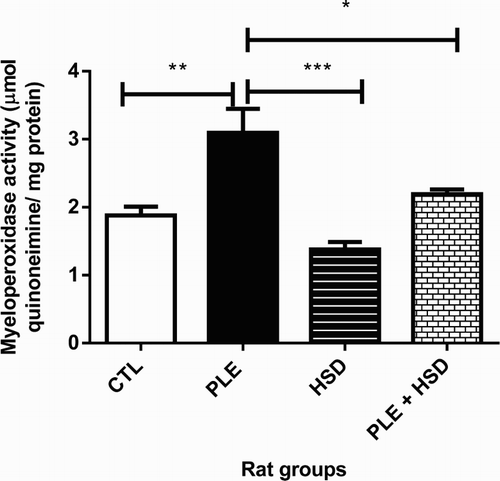
3.3. Effect of hesperidin on ROS production in rat pleural exudates and liver of carrageenan-induced pleurisy
(A) shows that there was a significant (P < 0.05) increase in ROS level as indicated by the fluorescence intensity ((B)) when the exudate cells were stained with DHR 123 in PLE group (4.88 ± 0.16 × 104 Arbitrary Unit [AU]), compared to the CTL (3.60 ± 0.18 × 104 AU) and HSD (2.97 ± 0.05 × 104 AU). However, excessive ROS production in exudates by carrageenan induction was reduced in PLE + HSD group (3.88 ± 0.08 × 104 AU). In addition, PLE (8.15 ± 0.86 nmol Unit of fluorescence (UFC)/mg protein) had significantly (P < 0.01) higher ROS level in the liver as shown by the fluorescence intensity when the supernatant from liver homogenate was stained with DCFH-DA, compared to the CTL (4.73 ± 0.45 nmol UFC/mg protein) and HSD (2.92 ± 0.71 nmol UFC/mg protein) (). However, PLE + HSD (6.09 ± 0.42 nmol UFC/mg protein) revealed significantly (P < 0.05) lower ROS level when compared to PLE group.
Figure 3. (A) Effect of hesperidin on ROS production in exudates cells of carrageenan-induced pleurisy. The results were expressed as mean ± SEM (n = 6), *P < 0.05, **P < 0.01 and ***P < 0.001 compared to the PLE or/and CTL group. (B) Representative plot of flow cytometric analysis of ROS production in pleural exudates cells using dihydrorhodamine 123 dye. Key: CTL: rats were administered saline solution only (Normal control group); PLE: rats were administered saline solution (NaCl 0.9%) orally and injected with carrageenan (Inflammation control group); HSD: rats were administered 80 mg/kg of hesperidin only (Hesperidin group); PLE + HSD: rats were administered 80 mg/kg hesperidin orally and intrapleurally injected with carrageenan (Inflammation treated with hesperidin group).
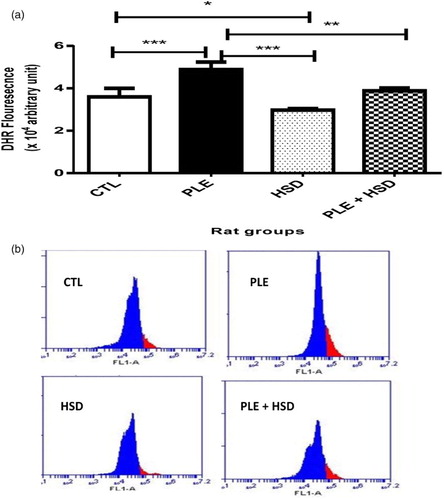
Figure 4. Effect of hesperidin on ROS production in rat liver of carrageenan-induced pleurisy. The results were expressed as mean ± SEM (n = 6), *P < 0.05, **P < 0.01 and ***P < 0.001 compared to the PLE or/and CTL group. Key: CTL: rats were administered saline solution only (Normal control group); PLE: rats were administered saline solution (NaCl 0.9%) orally and injected with carrageenan (Inflammation control group); HSD: rats were administered 80 mg/kg of hesperidin only (Hesperidin group); PLE + HSD: rats were administered 80 mg/kg hesperidin orally and intrapleurally injected with carrageenan (Inflammation treated with hesperidin group).
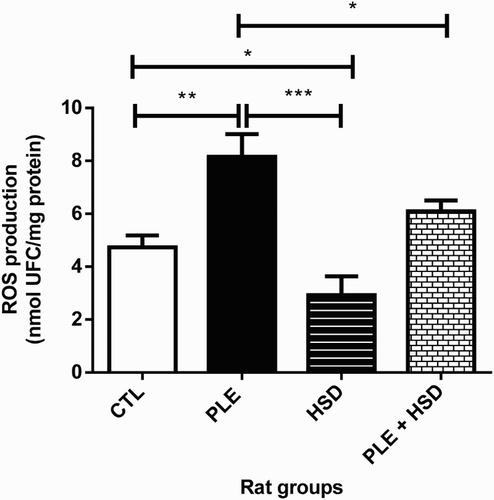
3.4. Effect of hesperidin on TBARS generation in rat liver of carrageenan-induced pleurisy
As shown in , a significant (P < 0.01) increase in TBARS level was observed in PLE (27.67 ± 2.37 nmol MDA/mg protein) in comparison to the CTL (17.04 ± 1.91 nmol MDA/mg protein). In a similar manner, HSD (11.54 ± 1.75 nmol MDA/mg protein) group had significantly (P < 0.05) lower TBARS level when compared to the CTL group. However, treatment with hesperidin inhibited TBARS production as seen in PLE + HSD group (18.36 ± 3.63 nmol MDA/mg protein).
Figure 5. Effect of hesperidin on TBARS generation in rat liver of carrageenan-induced pleurisy. The results were expressed as mean ± SEM (n = 6), *P < 0.05, **P < 0.01 and ***P < 0.001 compared to the PLE or/and CTL group. Key: CTL: rats were administered saline solution only (Normal control group); PLE: rats were administered saline solution (NaCl 0.9%) orally and injected with carrageenan (Inflammation control group); HSD: rats were administered 80 mg/kg of hesperidin only (Hesperidin group); PLE + HSD: rats were administered 80 mg/kg hesperidin orally and intrapleurally injected with carrageenan (Inflammation treated with hesperidin group).
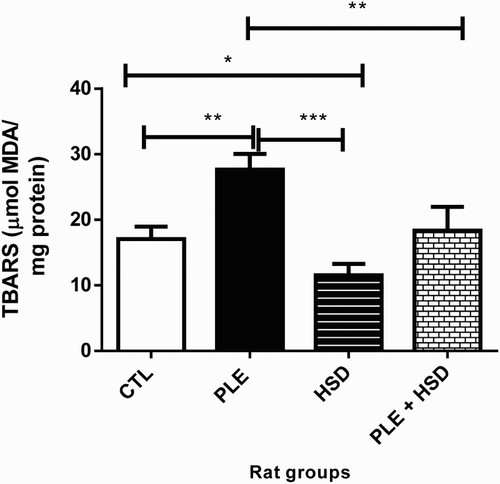
3.5. Effect of hesperidin on δ-ALAD activity in rat liver of carrageenan-induced pleurisy
Hepatic δ-ALAD activity () was significantly (P < 0.05) reduced in PLE (6.33 ± 1.08 nmol PBG/h/mg protein) when compared to the CTL (8.54 ± 0.51 nmol PBG/h/mg protein) and HSD (9.89 ± 0.58 nmol PBG/h/mg protein) groups. However, no significant (P > 0.05) different was noticed between PLE and PLE + HSD (6.85 ± 1.07 nmol PBG/h/mg protein) groups.
Figure 6. Effect of hesperidin on δ-ALAD activity in rat liver of carrageenan-induced pleurisy. The results were expressed as mean ± SEM (n = 6), *P < 0.05, **P < 0.01 and ***P < 0.001 compared to the PLE or/and CTL group. CTL: Control; PLE: Inflammation only; HSD: Hesperidin only; PLE + HSD: Inflammation with hesperidin.
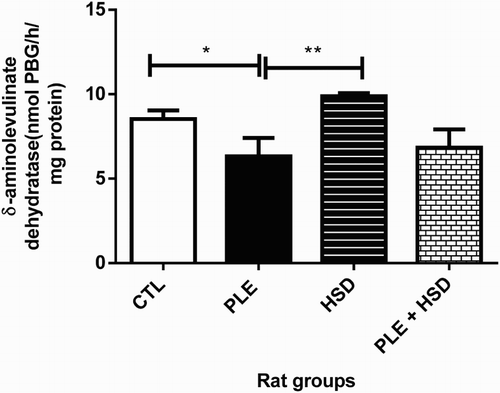
3.6. Effect of hesperidin on SOD in rat liver of carrageenan-induced pleurisy
The result of SOD activity is presented in . We observed a significant (P < 0.05) decrease in liver SOD activity of PLE group (5.63 ± 0.77 U/mg protein) compared to CTL group (6.89 ± 0.90 U/mg protein). However, HSD group (8.66 ± 1.60) had significantly (P < 0.01) higher liver SOD activity than the PLE group. It is worthy of note that there was a significant (P < 0.05) increase in the activity of SOD in liver of HSD group when compared to the CTL group. Also the PLE + HSD group (7.28 ± 0.57 U/mg protein) had significantly (P < 0.05) higher liver SOD than the PLE group.
Figure 7. Effect of hesperidin on SOD activity in rat liver of carrageenan-induced pleurisy. The results were expressed as mean ± SEM (n = 6), *P < 0.05, **P < 0.01 and ***P < 0.001 compared to the PLE or/and CTL group. Key: CTL: rats were administered saline solution only (Normal control group); PLE: rats were administered saline solution (NaCl 0.9%) orally and injected with carrageenan (Inflammation control group); HSD: rats were administered 80 mg/kg of hesperidin only (Hesperidin group); PLE + HSD: rats were administered 80 mg/kg hesperidin orally and intrapleurally injected with carrageenan (Inflammation treated with hesperidin group).
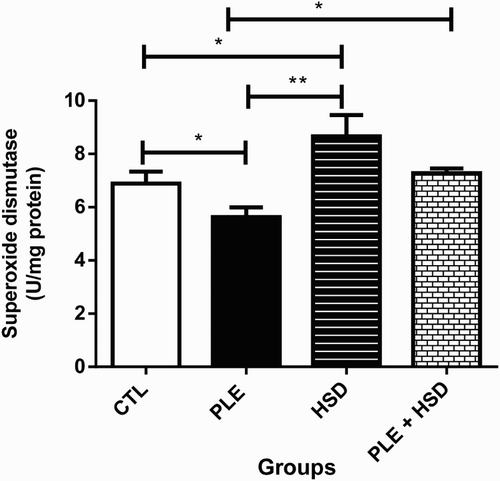
3.7. Effect of hesperidin on CAT in rat liver of carrageenan-induced pleurisy
The activity of liver CAT was evaluated and presented in . A significant (P < 0.05) decrease in CAT activity was observed in PLE group (35.10 ± 2.07 U/mg protein) when compared to the CTL (45.71 ± 2.99 U/mg protein) and PLE + HSD (43.76 ± 5.39 U/mg protein) groups. Also, we observed a significant (P < 0.05) increase in CAT activity of HSP group (57.61 ± 1.95 U/mg protein) when compared to the CTL group.
Figure 8. Effect of hesperidin on CAT activity in rat liver of carrageenan-induced pleurisy. The results were expressed as mean ± SEM (n = 6), *P < 0.05, **P < 0.01 and ***P < 0.001 compared to the PLE or/and CTL group. Key: CTL: rats were administered saline solution only (Normal control group); PLE: rats were administered saline solution (NaCl 0.9%) orally and injected with carrageenan (Inflammation control group); HSD: rats were administered 80 mg/kg of hesperidin only (Hesperidin group); PLE + HSD: rats were administered 80 mg/kg hesperidin orally and intrapleurally injected with carrageenan (Inflammation treated with hesperidin group).
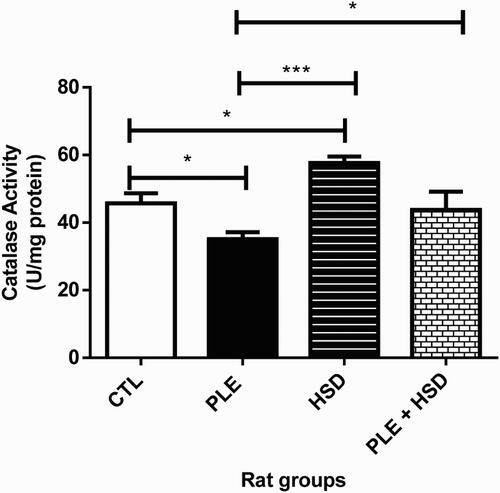
3.8. Effect of hesperidin on NPSH in rat liver of carrageenan-induced pleurisy
Liver NPSH level was determined and shown in . The result revealed that there was a significant (P < 0.01) reduction in liver NPSH level of PLE group (18.42 ± 1.39 µmol) when compared to the CTL (24.35 ± 0.61 µmol) and HSD (29.18 ± 0.34 µmol) groups. However, a significantly (P < 0.05) higher liver NPSH level was observed in PLE + HSD group (22.04 ± 2.04 µmol) when compared with PLE group.
Figure 9. Effect of hesperidin on NPSH level in rat liver of carrageenan-induced pleurisy. The results were expressed as mean ± SEM (n = 6), *P < 0.05, **P < 0.01 and ***P < 0.001 compared to the PLE or/and CTL group. Key: CTL: rats were administered saline solution only (Normal control group); PLE: rats were administered saline solution (NaCl 0.9%) orally and injected with carrageenan (Inflammation control group); HSD: rats were administered 80 mg/kg of hesperidin only (Hesperidin group); PLE + HSD: rats were administered 80 mg/kg hesperidin orally and intrapleurally injected with carrageenan (Inflammation treated with hesperidin group).
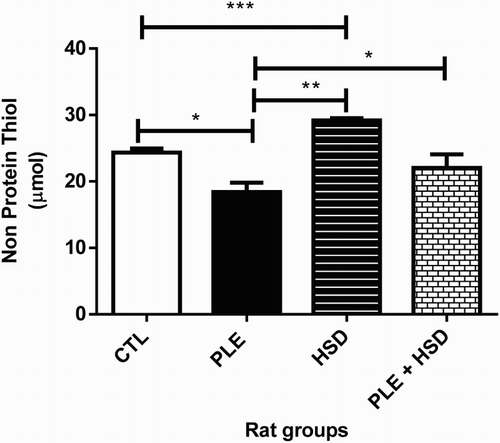
4. Discussion
The present study was undertaken using rat model of acute inflammation to evaluate the anti-inflammatory potential of hesperidin. In the present investigation, pretreatment with hesperidin showed remarkable anti-inflammatory action as evidenced by the reduction of exudate in the pleural cavity and leukocyte migration as well as inhibition of MPO activity, decrease in oxidative stress parameters (ROS and TBARS) and increase in antioxidant markers (δ-ALAD, SOD, CAT and NPSH)
Inflammation is a process that involves several cellular and molecular mechanisms in which numerous mediators participate in an effective and organized manner [Citation34]. However, an excessive inflammatory response could become harmful and may erroneously damage healthy tissue and compromise its functionality [Citation35]. In this study, increased exudate as well as elevated leukocyte influx into the pleural cavity were observed in carrageenan-induced rat. This may suggest an increased mobilization of cells to the inflammatory locations, as a result of production of chemotactic factors that could elevate blood flow to the region [Citation36]. This is in agreement with earlier study where injection of carrageenan into rat pleural space evoked pleurisy, characterized by migration of exudate and other cells to the area of injuries [Citation37]. The ability of hesperidin pretreatment to retard the exudate and leukocyte migration could be part of the potential anti-inflammatory mechanisms of hesperidin against oxidative stress-mediated injuries in the pleural space.
Control of neutrophil (a major cell involved in acute inflammation) migration into the lesion site, is an important factor for reducing inflammatory process and may represent a therapeutic strategy [Citation38]. Myeloperoxidase (MPO) is most abundantly expressed in neutrophil granulocytes (a subtype of white blood cells), and produces hypohalous acids to carry out their antimicrobial activity [Citation39]. It is a lysosomal protein stored in azurophilic granules of the neutrophil and released into the extracellular space during degranulation [Citation40]. In this study, increased MPO activity resulting from carrageenan injection may corroborate the report of Dalmarco et al. [Citation41] where inflammatory process was aggravated after carrageenan induction in mouse model of pleurisy. Hesperidin pretreatment in this experiment caused a marked reduction of MPO activity which may contribute to the inhibitory effect on the neutrophils, since this proinflammatory enzyme can reflect the activation of neutrophils. In addition, activation and accumulation of neutrophils is one of the hallmarks of initial tissue injury, due to the release of ROS, which play a key role in lung injury associated with acute inflammation in both animal and clinical studies [Citation42–45]. These species are cytotoxic agents; inducing lipid peroxidation and other cellular oxidative stress by cross-linking proteins, lipids and nucleic acids, which in turn, cause cellular dysfunction, damage and eventually death [Citation46].
Increasing oxidative effects may be quantified by elevation in ROS and reduction in the activity of antioxidant enzymes that protect cells from the deleterious substances [Citation47]. In this study, dihydrorhodamine 123 (DHR 123) was used as a substrate for assessing inflammatory burst in exudate cells. Increased ROS level as shown by the fluorescence intensity of DHR in exudates may indicate the proinflammatory effect of carrageenan. However, hesperidin may have elicited its anti-inflammatory effects by its antioxidant mechanisms [Citation47].
The antioxidant action of hesperidin was further investigated by assessing lipid peroxidation; an index of oxidative stress. The observed increase in lipid peroxidation in Cg-induced rat in this study correlates with previous report by Petronilho et al. [Citation48] and Muller et al. [Citation49]. Lipid peroxidation is known to be a causative factor that contributes to the pathophysiology of inflammation [Citation50]. However, pretreatment with hesperidin (80 mg/kg) showed significant antioxidant effect in acute inflammatory condition. These results support the assertion that there is a direct relationship between MPO activity and lipid peroxidation levels, pointing to the importance of neutrophil as a source of free radicals and inflammatory processes [Citation51].
Experimental evidences have shown that δ-ALAD is highly sensitive to the presence of a variety of pro-oxidant elements, which oxidize –SH groups of this enzyme impairing its activity [Citation52,Citation53]. The inhibition of δ-ALAD activity may prejudice heme biosynthesis and can result in the accumulation of aminolevulinic acid which can have pro-oxidant effects under physiologically conditions and contribute towards the induction of oxidative stress [Citation54]. In this study, the decreased δ-ALAD activity in Cg-induced rats, may suggest an increased oxidative stress which may subsequently be associated with aggravated acute inflammatory conditions. To further buttress this point, reduced level of hepatic NPSH was also observed in Cg-induced rats. It is worthy of note that pretreatment with hesperidin attenuated the decrease NPSH level as well as modulated the δ-ALAD activity caused by Cg-injection.
Antioxidant enzymes such as SOD and CAT play defensive role against ROS attack in cells. SOD is involved in the dismutation of superoxide radicals (O2 .- ) and hydrogen peroxide (H2O2), which is then reduced to water (H2O) by CAT [Citation55]. Decreased activity of CAT and SOD in Cg-induced rats may enhance the availability of O2 .- and H2O2 which can subsequently lead to the generation of hydroxyl radical (a powerful radical that can participate in Fenton reaction) and initiate oxidative damage to various biomolecules such as DNA, protein and lipid [Citation56]. However, the attenuation of the generation of the free radicals by hesperidin pretreatment in Cg-induced rats may suggest the antioxidant and anti-inflammatory effects of hesperidin in acute inflammatory process.
5. Conclusion
Hesperidin demonstrated significant antioxidant activity against ROS, TBARS and NPSH levels as well as δ -ALAD, SOD and CAT activities. Also, the findings obtained from the analysis of exudate volume, total leukocyte count and inhibition of MPO support the anti-inflammatory activity of hesperidin. Taken together, we show that hesperidin can effectively interfere in rat pleurisy induced by carrageenan (Cg) or acute inflammatory process.
Acknowledgement
The authors appreciate the assistance of Dr Ayokunle Ademosun of the Department of Biochemistry, Federal University of Technology, Akure, Nigeria, for proof reading the final version of manuscript.
Disclosure statement
No potential conflict of interest was reported by the authors.
Additional information
Funding
References
- Light RW, Gary Lee YC. Textbook of pleural diseases. London: Arnold; 2003.
- Kass SM, Williams PM, Reamy BV. Pleurisy. Am Fam Phys. 2007;75:1357–1364.
- Lentsch AB, Ward PA. Regulation of experimental lung inflammation. Respir Physiol. 2001;128:17–22. doi: 10.1016/S0034-5687(01)00260-2
- Nantel F, Denis D, Gordon R, et al. Distribution and regulation of cyclooxygenase-2 in carrageenan-induced inflammation. Br J Pharmacol. 1999;128:853–859. doi: 10.1038/sj.bjp.0702866
- Iwata M, Suzuki S, Asai Y, et al. Involvement of nitric oxide in a rat model of carrageenan-induced pleurisy. Mediators Inflamm. 2010;2010:1–11. doi: 10.1155/2010/682879
- Salvemini D, Wang ZQ, Bourdon DM, et al. Evidence of peroxynitrite involvement in the carrageenan-induced rat paw edema. Eur J Pharmacol. 1996;303:217–220. doi: 10.1016/0014-2999(96)00140-9
- Beckman JS. Oxidative damage and tyrosine nitration from peroxynitrite. Chem Res Toxicol. 1996;9:836–844. doi: 10.1021/tx9501445
- Zakim DB, Thomas D. Hepatology: a textbook of liver disease. 4th ed. Oxford, UK: Elsevier Health Sciences; 2002.
- Rosa M D, Giroud JP, Willoughby DA. Studies on the mediators of the acute inflammatory response induced in rats in different sites by carrageenan and turpentine. J Pathol. 1971;104:15–29. doi: 10.1002/path.1711040103
- Capasso F, Dunn CJ, Yamamoto S, et al. Further studies on carrageenan-induced pleurisy in rats. J Pathol. 1975;116:117–124. doi: 10.1002/path.1711160208
- Al-Mehdi A, Shuman H, Fisher A. Intracellular generation of reactive oxygen species during nonhypoxic lung ischemia. Am J Physiol. 1997;272:294–300.
- Ward PA. Oxidative stress: acute and progressive lung injury. Ann N Y Acad Sci. 2010;1203:53–59. doi: 10.1111/j.1749-6632.2010.05552.x
- Park YB, Do KM, Bok SH, et al. Interactive effect of hesperidin and vitamin E supplements on cholesterol metabolism in high cholesterol-fed rats. Int J Vitam Nutr Res. 2001;71:36–44. doi: 10.1024/0300-9831.71.1.36
- Suarez J, Herrera MD, Marhuenda E. In vitro scavenger and antioxidant properties of hesperidin and neohesperidin dihydrochalcone. Phytomedicine. 1998;5:469–473. doi: 10.1016/S0944-7113(98)80044-5
- Cospite M. Double-blind, placebo-controlled evaluation of clinical activity and safety of Daflon 500 mg in the treatment of acute hemorrhoids. Angiology. 1994;45:566–573. doi: 10.1177/000331979404500612
- Lee CJ, Wilson L, Jordan MA, et al. Hesperidin suppressed proliferations of both human breast cancer and androgen-dependent prostate cancer cells. Phytother Res. 2010;24:S15–S19. doi: 10.1002/ptr.2856
- Chiba H, Uehara M, Wu J, et al. Hesperidin, a citrus flavonoid, inhibits bone loss and decreases serum and hepatic lipids in ovariectomized mice. J Nutr. 2003;133:1892–1897.
- Ghali A, Bourneau-Martin D, Dopter A, et al. Thrombocytopenic purpura associated with dietary supplements containing citrus flavonoids. Therapie. 2015;70:555–556. doi: 10.2515/therapie/2015050
- Hussein M, Othman S. Structure activity relationship of antioxidative property of Hesperidin. Int J Pharm Dev. 2011;3:19–29.
- Chanet A, Milenkovic D, Manach C, et al. Citrus flavanones: what is their role in cardiovascular protection. J Agric Food Chem. 2012;60:8809–8822. doi: 10.1021/jf300669s
- Guardia T, Rotelli AE, Juarez AO, et al. Anti-inflammatory properties of plant flavonoids. Effects of rutin, quercetin and hesperidin on adjuvant arthritis in rat. Farmaco. 2001;56:683–687. doi: 10.1016/S0014-827X(01)01111-9
- Bradley PP, Priebat DA, Christensen RD, et al. Measurement of cutaneous inflammation: estimation of neutrophil content with an enzyme marker. J Invest Dermatol. 1982;78:206–209. doi: 10.1111/1523-1747.ep12506462
- Poll T, Opal SM. Pathogenesis, treatment, and prevention of pneumococcal pneumonia. Lancet. 2009;374:1543–1546. doi: 10.1016/S0140-6736(09)61114-4
- Amer J, Goldfarb A, Fibach E. Flow cytometric measurement of reactive oxygen species production by normal and thalassaemic red blood cells. Eur J Haematol. 2003;70:84–90. doi: 10.1034/j.1600-0609.2003.00011.x
- Ali SF, Lebe CP, Bondy SC. Reactive oxygen species formation as a biomarker of methylmercury and trimethyltin neurotoxicity. Neurotoxicology. 1992;113:637–648.
- Bass DA, Parce JW, Dechatelet LR, et al. Flow cytometric studies of oxidative product formation by neutrophils: a graded response to membrane stimulation. J Immunol. 1983;1130:1910–1917.
- Jentzsch AM, Bachmann H, Furst P, et al. Improved analysis of malondialdehyde in human body fluids. Free Rad Biol Med. 1996;20:251–256. doi: 10.1016/0891-5849(95)02043-8
- Sassa S. Delta-aminolevulinic acid dehydratase assay. Enzyme. 1982;28:133–145.
- McCord JM, Fridovich I. Superoxide dismutase. An enzymic function for 473 erythrocuprein. J Biol Chem. 1996;244:6049–6055.
- Nelson DP, Kiesow LA. Enthalpy of decomposition of hydrogen peroxide by catalase at 25°C (with molar extinction coefficients of H2O2 solutions in the UV). Anal Biochem. 1972;49:474–478. doi: 10.1016/0003-2697(72)90451-4
- Aebi H. Catalase in vitro. Methods Enzymol. 1984;105:121–126. doi: 10.1016/S0076-6879(84)05016-3
- Habig W, Pabst M, Jakoby W. Glutathione S-transferase, the first enzymatic step in mercapturic acid formation. J Biol Chem. 1974;249:7130–7139.
- Bradford M. A rapid and sensitive method for quantitation of microgram quantities of protein utilizing the principle of protein–dye binding. Anal Biochem. 1976;72:248–254. doi: 10.1016/0003-2697(76)90527-3
- Medzhitov R. Origin and physiological roles of inflammation. Nature. 2008;454:428–435. doi: 10.1038/nature07201
- Nathan C. Neutrophils and immunity: challenges and opportunities. Nat Rev Immunol. 2006;6:173–182. doi: 10.1038/nri1785
- Ueno A, Oh-ishi S. Critical roles for bradykinin and prostanoids in acute inflammatory reactions: a search using experimental animal models. Curr Drug Tar Inflamm Allergy. 2002;1:363–376. doi: 10.2174/1568010023344553
- Moore AR. Pleural models of inflammation: immune and non-immune. Methods Mol Biol. 2003;225:123–128.
- Li JL, Ng LG. Peeking into the secret life of neutrophils. Immunol Res. 2012;53:168–181. doi: 10.1007/s12026-012-8292-8
- Klebanoff SJ. Myeloperoxidase: friend and foe. J Leukoc Biol. 2005;77:598–625. doi: 10.1189/jlb.1204697
- Kinkade JM, Pember SO, Barnes KC, et al. Differential distribution of distinct forms of myeloperoxidase in different azurophilic granule subpopulations from human neutrophils. Biochem Biophys Res Commun. 1983;114:296–303. doi: 10.1016/0006-291X(83)91627-3
- Dalmarco EM, Fröde TS, Medeiros YS. Effects of methotrexate upon inflammatory parameters induced by carrageenan in the mouse model of pleurisy. Mediators Inflamm. 2002;11:299–306. doi: 10.1080/09629350210000015700
- Petronilho F, deSouza B, Vuolo F, et al. Protective effect of gastrin- releasing peptide receptor antagonist in carrageenan-induced pleural inflammation in rats. Inflamm Res. 2010;59:783–789. doi: 10.1007/s00011-010-0190-8
- Albano MN, daSilveira MR, Danielski LG, et al. Anti-inflammatory and antioxidant properties of Hydroalcoholic crude extract from Casearia sylvestris Sw (Salicaceae). J Ethnopharmacol. 2013;147:612–617. doi: 10.1016/j.jep.2013.03.049
- Huang R, Zhong T, Wu T. Quercetin protects against lipopolysaccharide-induced acute lung injury in rats through suppression of inflammation and oxidative stress. Arch Med Sci. 2015;2:427–432. doi: 10.5114/aoms.2015.50975
- Turowski JB, Pietrofesa RA, Lawson JA, et al. Flaxseed modulates inflammatory and oxidative stress biomarkers in cystic fibrosis: a pilot study. BMC Complement Altern Med. 2015;15:240. doi: 10.1186/s12906-015-0651-2
- Pisoschi AM, Pop A. The role of antioxidants in the chemistry of oxidative stress: a review. Eur J Med Chem. 2015;97:55–74. doi: 10.1016/j.ejmech.2015.04.040
- Smith JA, Weidemann MJ. Further characterization of the neutrophil oxidative burst by flow cytometry. J Immunol Methods. 1993;162:261–268. doi: 10.1016/0022-1759(93)90391-J
- Petronilho F, Dal-Pizzol F, Costa GM, Kappel VD, deOliveira SQ, Fortunato J, Cittadini-Zanette B, Moreira JC, Simões CM, Dal-Pizzol F, Reginatto FH. Hepatoprotective effects and HSV-1 activity of the hydroethanolic extract of Cecropia glaziovii (Embaúba-Vermelha) against acyclovir-resistant strain. Pharm Biol. 2015;50:911–918. doi: 10.3109/13880209.2011.643902
- Müller SD, Florentino D, Ortmann CF, et al. Anti-inflammatory and antioxidant activities of aqueous extract of Cecropia glaziovii leaves. J Ethnopharmacol. 2016;185:255–262. doi: 10.1016/j.jep.2016.03.007
- Guéraud F, Atalay M, Bresgen N, et al. Chemistry and biochemistry of lipid peroxidation products. Free Radic Res. 2010;44:1098–1124. doi: 10.3109/10715762.2010.498477
- Sureda A, Tauler P, Aguiló A, et al. Relation between oxidative stress markers and antioxidant endogenous defences during exhaustive exercise. Free Radic Res. 2005;39:1317–1324. doi: 10.1080/10715760500177500
- Nogueira CW, Soares FA, Nascimento PC, et al. 2,3-Dimercaptopropane – 1-sulfonic acid and meso-2,3-dimercaptosuccinic acid increase mercury and cadmium-induced inhibition of delta-aminolevulinate dehydratase. Toxicol. 2003;184:85–95. doi: 10.1016/S0300-483X(02)00575-9
- Brito VB, Folmer V, Soares JC, et al. Long-term sucrose and glucose consumption decreases the delta-aminolevulinate dehydratase activity in mice. Nutrition. 2007;23:818–826. doi: 10.1016/j.nut.2007.08.002
- Bechara EJ. Oxidative stress in acute intermittent porphyria and lead poisoning may be triggered by 5-aminolevulinic acid. Braz J Med Biol Res. 1996;29:841–851.
- Halliwell B, Gutteridge JM. Free radicals in biology and medicine. Oxford, UK: Oxford University Press; 1999.
- Fridovich I. Superoxide dismutases. Adv Enzymol Relat Areas Mol Biol. 1986;58:61–97.

